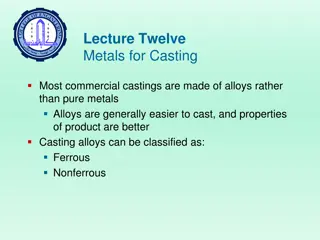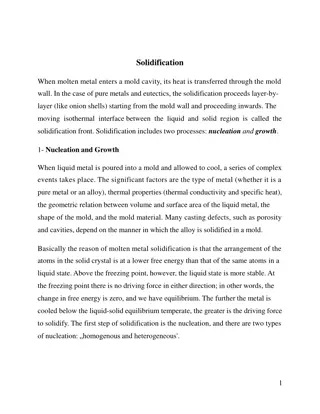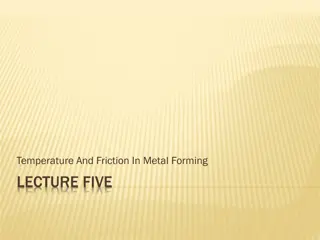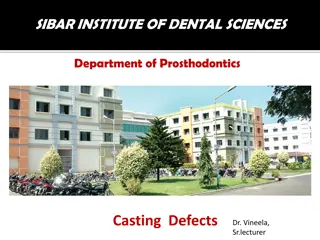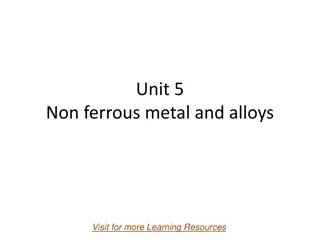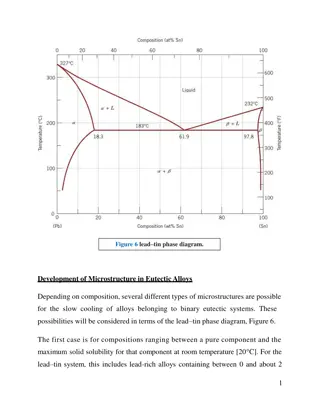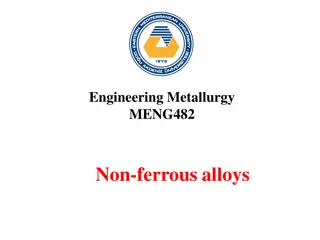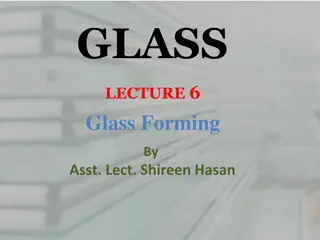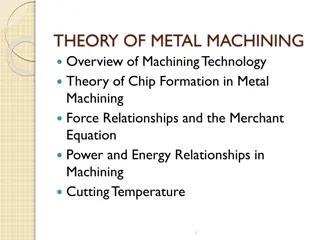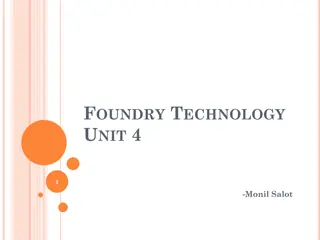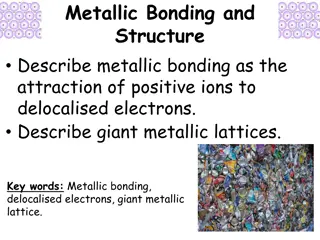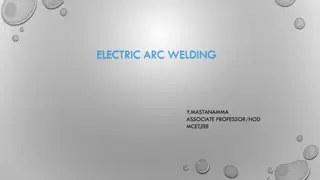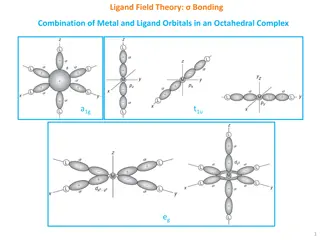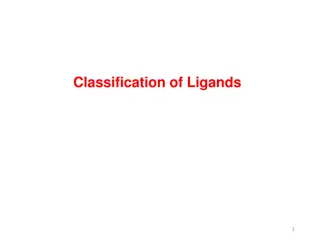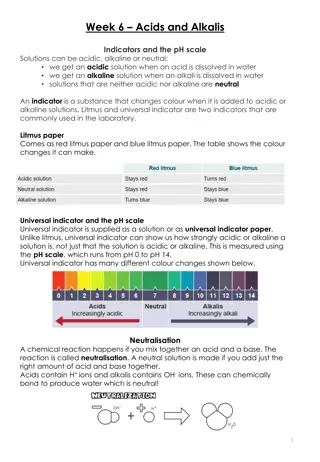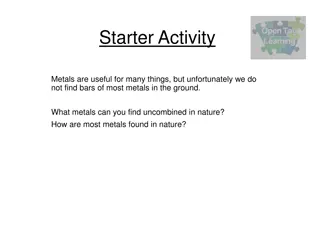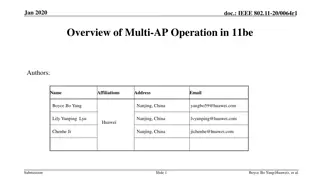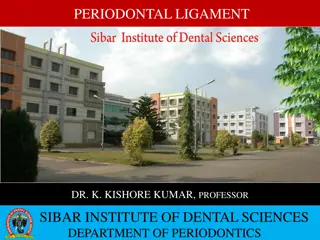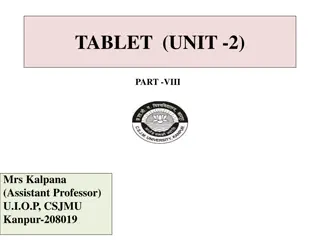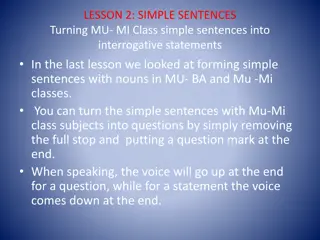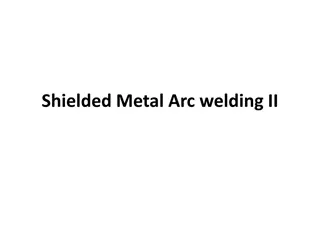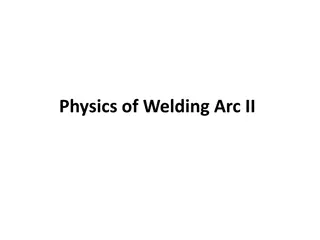Metal Alloys Forming Operations: Forging, Casting, and More
Metal alloys undergo forming operations like forging, rolling, extrusion, and casting to change their shape through plastic deformation. Hot working and cold working processes are utilized to enhance mechanical properties. Techniques such as sand casting, die casting, and investment casting are employed to create metal parts with specific shapes.
Download Presentation

Please find below an Image/Link to download the presentation.
The content on the website is provided AS IS for your information and personal use only. It may not be sold, licensed, or shared on other websites without obtaining consent from the author. Download presentation by click this link. If you encounter any issues during the download, it is possible that the publisher has removed the file from their server.
E N D
Presentation Transcript
CHAPTER 8: METAL ALLOYS A. FORMING OPERATIONS: In forming operations, the shape of the metal is changed by plastic deformation; for example: forging (d vme), rolling, extrusion, and drawing are common forming techniques. Hot working: When deformation is achieved at a temperature above which recrystallizaiton occurs, this process is called hot working. 1
CHAPTER 8: METAL ALLOYS Cold working: This process produces an increase in strength and decrease in ductility. This produces a high quality surface and better mechanical properties. But, it is an expensive procedure. 2
Forging: It is accomplished by hammering on a single piece of metal. Example: Railroad wheels are formed by using this technique. Rolling: It is the most widely used deformation process, consists of passing a piece of metal between two rolls. Example: Railroad rails are formed by using this technique. 3
Extrusion: A bar of metal is forced through a hole by a compressive force. The extruded piece has the desired shape. Example: Metal tubes. Drawing: It is the pulling of a metal piece through a die by a tensile force. After drawing, the cross-section of the metal reduces and its length increases. 4
B. CASTING (dkme): Casting is a fabrication process in which a totally molten metal is poured into a mold cavity. When metal solidifies, the metal takes the shape of the mold. There are three types of casting techniques: 5
1. Sand Casting: This is the most common method, ordinary sand is used as the mold material. Sand-cast parts include automotive cylinder blocks, large pipes. 2. Die casting: In this casting method, liquid metal is forced into a mold under pressure and at a relatively high velocity, then the liquid metal is allowed to solidify with the pressure. Example: Alloys of zinc, aluminium and magnesium are casted with this method. 6
3. Investment casting: In this casting method, the mold pattern is made from a wax or plastic that has a low melting temperature. Example: It is used in jewelry. 7
C. OTHER TECHNIQUES: 1. Powder Metallurgy: A more dense metal is produced when the powdered metal is compacted followed by a heat treatment. This process is called powder metallurgy. Example: Gears are made with this technique. 2. Welding: In welding, two or more metal parts are joined to from a single piece when one-part fabrication is expensive . 8
A. FERROUS (demirli) ALLOYS: Iron (demir) is the main metal. Ferrous alloys are produced in large quantities than any other metal. They are used in construction business. Figure 8.2: Classification of ferrous alloys. Ferrous alloys are steels, cast- irons. 9
1. Steels: They are mainly carbon-iron alloys. In addition to carbon and iron, they sometimes have other elements. They have less than 1.0 weight % carbon. Some of the steels are named as low-carbon steels, medium-carbon steels and high-carbon steels. a. Low-carbon steels: They generally contain less than 0.25 weight % carbon. Typical applications are auto body parts, structural parts for buildings, bridges. 10
b. Medium-carbon steels: They have carbon concentrations between 0.25 and 0.60 weight %. Typical applications are railway wheels and tracks, gears, and other machine parts. c. High-carbon steels: They have carbon concentrations between 0.60 and 1.4 weight %. Typical applications are woodworking tools, concrete drills, etc. 11
d. Stainless steels: They are highly resistant to corrosion. At least 11 weight % chromium is reqired in order to prevent corrosion. Typical applications are gas turbines, aircraft, missiles, nuclear power generating units. 12
2. Cast (dkm)-Irons: They are a class of ferrous alloys with carbon contents above 2.1 weight %. Most cast irons contain between 3.0 and 4.5 weight % Carbon and other alloying elements. Some types of cast-irons are gray iron, ductile iron and white iron. 13
B. NONFERROUS ALLOYS: Ferrous alloys have some disadvantages: 1. They have high density; 2. They have low electrical conductivity; 3. They are sometimes not resistant to corrosion. For this reason, other metal alloys should be produced. Some of the nonferrous alloys are made from copper, aluminium, magnesium, titanium. 1. Copper (bak r) and Its Alloys: 2. Aluminum and Its Alloys: 3. Magnesium and Its Alloys: 4. Titanium and Its Alloys: 14
1. Copper (bakr) and Its Alloys: Pure copper is very soft and ductile. Pure copper is very resistant to corrosion. The most common copper alloy is called brass (pirin ). In brass, copper is mixed with zinc ( inko). The second common copper alloy is called bronze (tun ). In bronze, copper is mixed with other elements such as tin, aluminium, silicon, and nickel. Applications of copper alloys are: jet gears and dental instruments. 15
2. Aluminum and Its Alloys: Aluminium and its alloys have very low densities. They are resistant to corrosion and they have high electrical and thermal conductivities. Applications of aluminium alloys are: aircraft structural parts, bus bodies, automotive parts. 16
3. Magnesium and Its Alloys: Magnesium has the lowest density among metals. (d=1.7gr/cm3). Magnesium alloys have very light weight, and for this reason they are used in aircraft components. In magnesium alloys, magnesium is mixed with other elements such as aluminium, zinc and manganese. Magnesium alloys are used in aircraft and missile (f ze) applications and in automotive industry. 17
4. Titanium and Its Alloys: Titanium alloys are very new. They are very expensive. Titanium alloys are used in airplanes, space vehicles, and in petroleum and chemical industries. 18


